3.4.1Management Board Remuneration Policy
The Supervisory Board aims at remunerating members of the Management Board in a competitive, flexible and predictable manner. In order to achieve this and to ensure remuneration within SBM Offshore contributes to long-term value creation, a remuneration policy is in place. The current version of the remuneration policy (called RP20151) has been effective as per January 1, 2015, after approval by the Annual General Meeting.
In order to support the Supervisory Board in its responsibilities an Appointment and Remuneration Committee (hereafter A&RC) is in place. The A&RC advises the Supervisory Board regarding remuneration matters and proposes resolutions within the framework of the remuneration policy.
The Remuneration Policy 2015 aims at driving the right behavior and consists of four components: (1) Base Salary, (2) Short-Term Incentive, (3) Long-Term Incentive and (4) Pension and benefits. These components are explained below.
1. Base salary
The Supervisory Board wants base salary levels for Management Board members to reflect the extent of their day-to-day responsibilities and to reward them in their effort in meeting these responsibilities in a competitive manner.
In order to determine a competitive base salary level, the Supervisory Board compares base salary levels of the Management Board with relevant companies in the industry but has also indicated that SBM Offshore does not want to be part of the 25% highest rewarding companies on base salary in the relevant market. The Supervisory Board uses the reference group of relevant companies in the industry (hereafter the Pay Peer Group) not only to determine base salary levels but also for monitoring total remuneration levels of the Management Board. Base salaries of the Management Board members and the Pay Peer Group are reviewed annually.
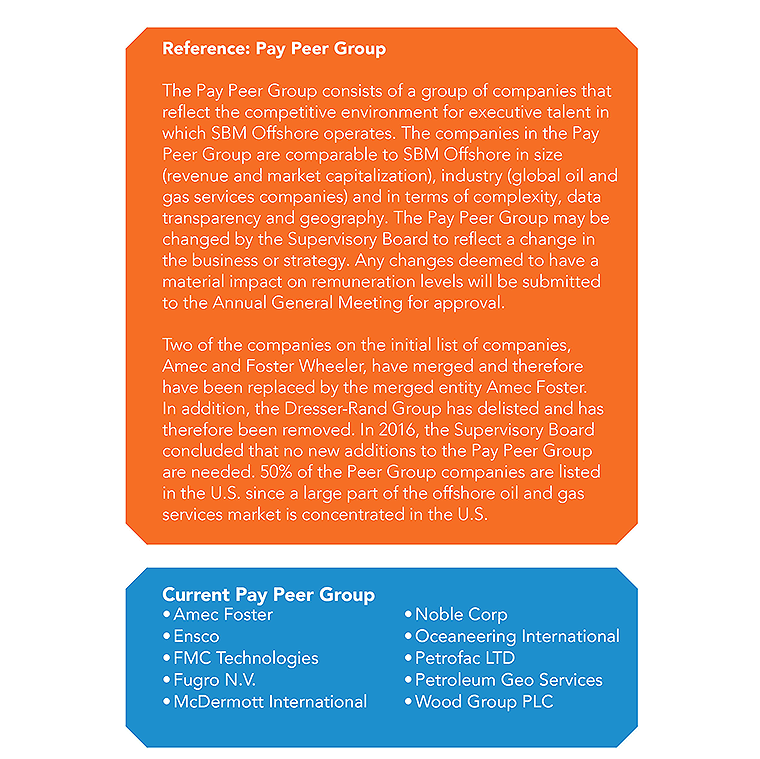
2. Short-Term Incentive
The Supervisory Board uses the Short-Term Incentive (STI) to reward the Management Board for delivering the Company’s short-term objectives, as derived from the long term strategy, for a specific year. The following graph shows the maximum STI value that can be attained.
Maximum STI to be attained
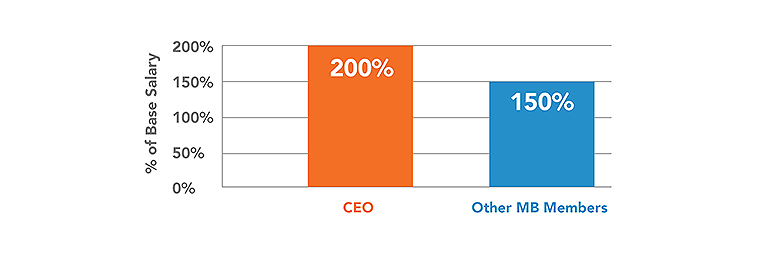
In order to reach these maximum values, the Management Board must need to achieve multiple objectives as displayed in the following figure :
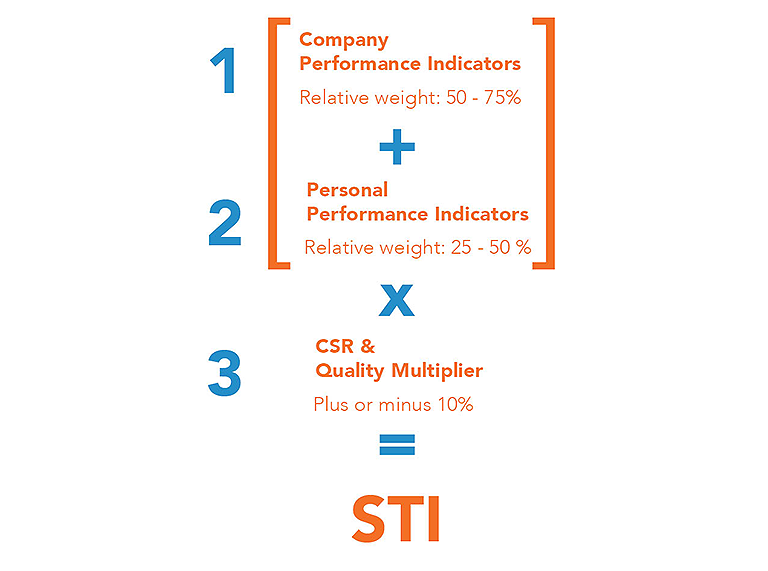
The Company Performance Indicators (1) and Personal Performance Indicators (2) together have a relative weight of 100%. The Corporate Social Responsibility & Quality Multiplier can cause a 10% in- or decrease of the total STI value based on safety and quality performance in combination with SBM Offshore’s Dow Jones Sustainability Index score. In case 100% of the Company and Individual Performance Indicators have been realized, the multiplier will not provide any additional uplift.
At the beginning of each year, the Supervisory Board, at the recommendation of the A&RC, sets the performance indicators and their respective weighting. The chosen performance indicators are based on the Company’s operating plan. For each Company Performance Indicator a scenario analysis is performed to determine a threshold, target and maximum level considering market and investor expectations as well as the economic environment. The ’Achievement Range for Company Performance Indicators’ graph displays the actual range application for Company Performance Indicators.
Achievement range for Company Performance Indicators
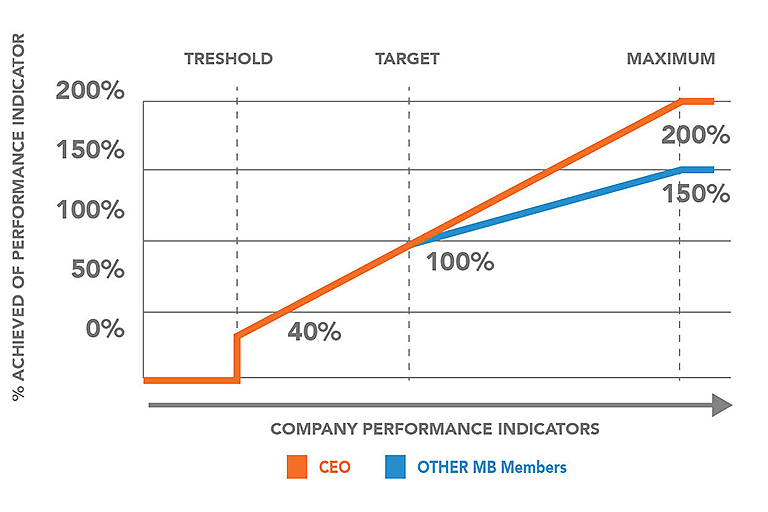
The details around selected Company Performance Indicators and their weightings are deemed commercially sensitive and are therefore unfit for predisclosure. However, SBM Offshore does disclose the selected Performance Indicators applied over the previous year in the Remuneration Report at the end of each performance year. As such, the Company Performance Indicators applicable in 2016 are mentioned in section 3.4.2 of this report.
At the end of the year, the A&RC reviews the performance of the Management Board members compared on the chosen Performance Indicators and makes a recommendation to the Supervisory Board to determine the STI pay-out level. The STI is payable in cash after the publication of the annual financial results for the performance year.
3. Long-Term Incentive
The Supervisory Board uses the Long-Term Incentive (LTI) as a retention instrument and to reward the Management Board for delivering the Company’s long-term objectives over a three year period, as derived from the Company’s strategy, and as such their contribution to long-term value creation.
The maximum LTI value is determined by the number of shares that can be attained by the Management Board. Each year, on a conditional basis, shares of Company stock (so-called restricted share units) are granted to Management Board members. A share pool of 1% of the Company’s share capital (as of year-end prior to the performance period) is available for share based awards for all staff including the Management Board. The Supervisory Board, upon recommendation of the A&RC, determines the proportion of the share pool that shall be available to the Management Board. The current proportion is 20% of which 40% is reserved for the CEO and 20% for each remaining Management Board Member. The graph below shows the maximum LTI value that can be attained.
Maximum LTI to be Attained
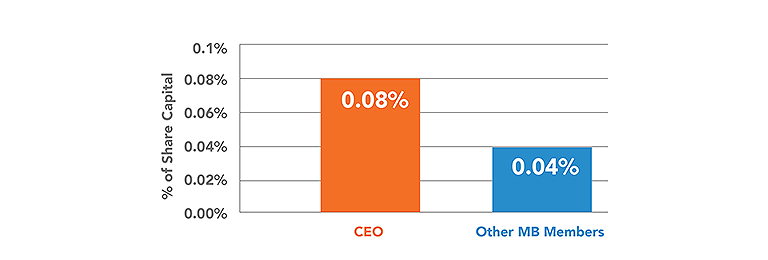
In order to reach these maximum values, the Management Board needs to achieve multiple objectives as are displayed in the following figure.

At the beginning of each year, the Supervisory Board, at the recommendation of the A&RC, chooses one or more of the three performance indicators and determines their respective weighting. For each performance indicator a scenario analysis is performed to determine threshold, target and maximum levels considering market and investor expectations as well as the economic environment.
The following graph displays the actual range application for the performance indicators. This process (i.e the linear approach between threshold, target and maximum) is equal to the STI approach.
Achievement Range for LTI Performance Indicators

After the end of each year, the Supervisory Board, at recommendation of the A&RC, assesses the extent to which the chosen LTI Performance Indicators have been met and decides upon the number of shares that will vest. These shares vest after publication of the annual results.
The vested LTI shares are restricted for an additional two years following the vesting date with the exception of those shares that are sold to satisfy taxes levied on the value of the vested LTI shares.
4. Pension
The Management Board members are responsible to create their own pension arrangements. In order to facilitate this, they receive a pension allowance equal to 25% of their Base Salary. This approach also applies to employees working in the headquarters in the Netherlands. SBM Offshore has chosen not to offer a (global) companywide pension scheme to its employees due to the strong international character of the Company and the fact that pensions are highly regulated by local legislation.
Other key elements of the Management Board remuneration and employment agreements
Adjustment of remuneration and clawback
The service contracts of the Management Board members contain an adjustment clause giving discretionary authority to the Supervisory Board to adjust upwards or downwards the payment of any variable remuneration component that has been conditionally awarded, if a lack of adjustment would produce an unfair or unintended result as a consequence of extraordinary circumstances during the period in which the performance criteria have been or should have been achieved. In addition, a claw-back provision is included in the service contracts enabling the Company to recover variable remuneration components on account of incorrect financial data. The provisions of the Dutch regulations on the revision and claw-back of variable remuneration and its provisions related to change of control arrangements apply. Under the claw-back provisions, STI and LTI awards can be clawed back at the discretion of the Supervisory Board, upon recommendation of the A&RC in the event of a misstatement of the results of the Company or an error in determining the extent to which performance indicators were met.
Severance Arrangements
The Supervisory Board, upon recommendation of the A&RC will determine the appropriate severance payment provided it will not exceed a sum equivalent to one times annual base salary, or if this is manifestly unreasonable in the case of dismissal during the first appointment term, two times the annual base salary. For each Management Board member, the appropriate level of severance payment is assessed in relation to remuneration entitlements in previous roles. As a result, the severance payment in case of termination is set within the boundaries of the Dutch Corporate Governance Code.
In principle, in the case of early retirement, end of contract, disability or death, any unvested LTI shares vest pro-rata, with discretion for the Supervisory Board, to increase or decrease the final number of LTI shares vesting up to the maximum opportunity. In the case of resignation or dismissal, any unvested LTI shares will be forfeited unless the Supervisory Board determines otherwise.
Share Ownership Requirement
Each Management Board member must build-up a specific percentage of base salary in share value in SBM Offshore. For the CEO this level is set at an equivalent of 300% of base salary and for the other Management Board members, the level is set at 200%. The Management Board must retain vested shares in order to acquire the determined shareholding level. An exception is made in case Management Board members wish to sell shares to satisfy tax obligations in relation to LTI shares. Unvested shares do not count towards the requirement.
Loans
SBM Offshore does not provide loans or advances to Management Board members and does not issue guarantees to the benefit of Management Board members.
Expenses and Allowances
The Management Board members are entitled to a defined set of emoluments and benefits. A general benefit in this area is the provision of a company car allowance. Other benefits depend on the personal situation of the relevant Management Board members and may include medical and life insurance and a housing allowance.